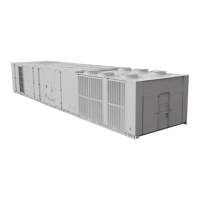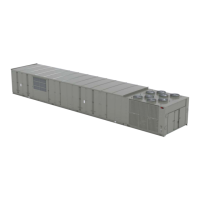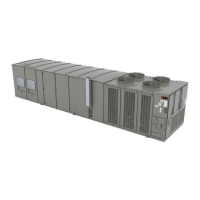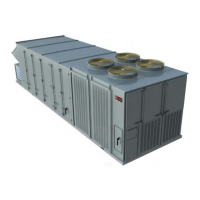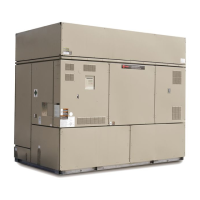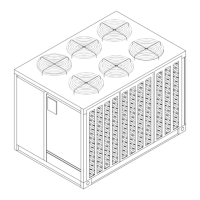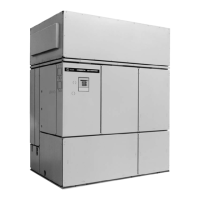Installation
52 RT-SVX36K-EN
4. Install a “Gate” type valve in the supply branch line as
close as possible to the hot water main and upstream
of any other device or takeoff.
5. Install a “Gate” type valve in the return branch line as
close as possible to the return main and down stream
of any other device.
6. Install a strainer in the hot water supply branch as
shown in Figure 35 and Figure 44.
7. Install the 3-way valve in an upright position, piped for
valve seating against the flow. Ensure that the valve's
location lends itself to serviceability.
8. TheType “W” hot water coil used in SLHL units is self-
venting only when the tube water velocity exceeds 1.5
feet per second (fps). If the tube velocity is less than 1.5
feet per second, either:
a. install an automatic air vent at the top of the return
header, using the tapped pipe connection;
or,
b. vent the coil from the top of the return header down
to the return piping. At the vent connection, size the
return piping to provide sufficient water velocity.
9. Install a“Globe” type valve in the Bypass line as shown
in Figure 35, p. 53 and Figure 44, p. 72.
Steam Heat Units (SSH_)
Steam heating coils are factory installed inside the heater
section of the unit.The coils are pitched, within the units,
to provide the proper condensate flow from the coil.To
maintain the designed degree of pitch for the coil, the unit
must be level.
Once the unit is set into place, the steam piping and the
factory provided two way modulating valve must be
installed.The valve can be installed inside the heater
section or near the unit. If the valve is installed in a remote
location, use field supplied wiring to extend the control
wires from the heater section to the valve.Two access
holes are provided in the unit base as illustrated in
Figure 15, p. 29.
Following the guidelines listed below will enhance both
the installation and operation of the “wet heat” system.
Figure 37, p. 54 and Figure 38, p. 54 illustrate the
recommended piping configurations for the steam coil.
Table 27, p. 62 lists the coil connection sizes.
Note: The valve actuators are not waterproof. Failure to
protect the valve from moisture may result in the
loss of heating control.
1. Support all field-installed piping independently from
the heating coil.
2. Use swing joints or flexible connectors adjacent to the
heating coil. (These devices will absorb the strains of
expansion and contraction.)
3. Install the 2-way valve in an upright position. Ensure
that the valve's location lends itself to serviceability.
4. Pitch the supply and return steam piping downward 1"
per 10' of run in the direction of flow.
5. All return lines and fittings must be equal to the
diameter of the “outlet” connection on the steam
coil(s). If the steam trap connection is smaller that the
coil “outlet” diameter, reduce the pipe size between
the strainer and the steam trap connections only.
6. Install a 1/2” 15 degree swing-check vacuum breaker at
the top of the return coil header using the tapped pipe
connection. Position the vacuum breaker as close to
the coil as possible.
Note: Vacuum breakers should have extended lines from
the vent ports to the atmosphere or connect each
vent line to the return pipe on the discharge side of
the steam traps.
7. Install a “Gate” type valve in the supply branch line as
close as possible to the steam main and upstream of
any other device.
8. Install a “Gate” type valve in the return branch line as
close as possible to the condensate return main and
downstream of any other device.
9. Install a strainer as close as possible to the inlet of the
control valve and steam trap(s).
10. Steam trap selection should be based on the
maximum possible condensate flow and the
recommended load factors.
11. Install a Float-and-Thermostatic (FT) type trap to
maintain proper flow.They provide gravity drains and
continuous discharge operation. FT type traps are
required if the system includes either;
a. an atmospheric pressure/gravity condensate
return;
or,
b. a potentially low pressure steam supply.
12. Position the outlet or discharge port of the steam trap
at least 12" below the outlet connection on the coil(s).
This will provide adequate hydrostatic head pressure
Table 21. Connection sizes for hot water and steam
coil
(a)
(a)Type W coils-with center offset headers-are used in SLH* units; Type
NS coils are used in SSH* units
Coil Connections
(diameter in
inches)
Unit Model and Size
Heat Section
Capacity
(b)
(b)See Digit 9 of the unit model number to determine the heating capacity.
Supply Return
SLH*-20 to 130 High or Low Heat 2-1/2" 2-1/2"
SSHL-20 to 36 High or Low Heat 3" 1-1/4"
SSHL-40 to 89
(c)
(c) SSH* - 40 to 89 Ton units have multiple headers.
High Heat Low Heat 3" 1-1/2"
SSHK-90 to 130 Low Heat(c) 1-1/2” 1”

